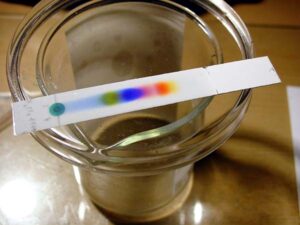Case History
A-58-year-old female with past medical history of breast cancer in remission, renal transplant 8 years ago on tacrolimus, now presenting with inability to tolerate oral intake, dyspnea on exertion and gastrointestinal symptoms such as profuse foul-smelling, non-bloody diarrhea, and vomiting. She denied exposure to sick contacts, recent travel, or changes in diet. She had other co-morbidities including hypertension, atrial arrhythmia, hyperlipidemia, and past C. difficile infection. On the physical exam, she was afebrile, normotensive, with a normal heart rate and rhythm, and her abdomen is soft and non-distended, with tenderness to palpation. Cardiology was consulted due to new onset paroxysmal atrial fibrillation on telemetry, and the renal transplant team was contacted for admission in concern for her rising creatinine. Upon admission to the floor, the patient had 2 more loose stools which were collected for stool culture and multiplex, syndromic gastrointestinal PCR panel, which tested positive for norovirus. She was kept on contact precautions.
Discussion
Norovirus is a single stranded positive-sense RNA virus belonging to the Calciciviridae family. Noroviruses are divided into 10 genogroups based on the amino acid sequence of VP1, the norovirus capsid protein. Genogroups GI and GII account for 90% of reported infections including outbreaks, with the GII.4 genotype being the cause of most severe disease, and it is more frequently implicated in outbreaks than other genotypes (1).
The median incubation period for norovirus infections is 1.2 days, with most symptomatic patients presenting with diarrhea and vomiting. Asymptomatic shedding of norovirus is common, mainly in the pediatric population, where 11.6 – 49.2% of stool samples were found to contain norovirus in random recruitment studies globally. Most patients with norovirus infection have spontaneous resolution of symptoms by the third day of illness. Elderly, young, and immunocompromised patients face greater risk of severe and prolonged symptoms from norovirus infection. Chronic infection with norovirus may occur in immunocompromised hosts, with associated symptoms lasting up to weeks or months in these patients (2).
Transmission of norovirus occurs through oral-oral and fecal-oral routes, and transmission can occur directly via exposure to human emesis or feces, or through contamination of food, water, or fomites with such samples. Median viral titers have been recorded at 3.9 x 104 copies/mL in emesis samples from patients with norovirus GII, with aerosolization of viral particles possible due to projectile vomiting and toilet flushing (de Graaf). Once inoculated, norovirus particles primarily infect macrophages and dendritic cells in the gastrointestinal tract, with current reports suggesting that particles enter these cells via attachment to blood group antigens, or HGBAs, and Toll-like receptors (3). VP1, the capsid protein of norovirus, has been found to induce expression of aquaporin-1 in human intestinal cell culture. This leads to small molecule permeability at the intestinal barrier, which likely leads to the watery diarrhea seen in norovirus infection (4).
Norovirus is implicated as the cause of 19% of all acute gastroenteritis cases globally, with virtually every country reporting norovirus cases (5). These infections frequently occur in the form of outbreaks, with the highest rates of infection recorded in the winter months (Figure 1). Crowded and closed environments, including daycare centers, cruise ships, and restaurants, are known facilitators of outbreaks. More than half of all norovirus outbreaks are reported in healthcare settings, such as hospitals and long-term care facilities (6).

Immunological assays (e.g., antigen detection) and transmission electron microscopy can be used for detection of gastrointestinal viruses, but these methods have limited sensitivity and specificity and not recommended for clinical diagnosis (7). Laboratory detection by molecular methods is the preferred method for norovirus diagnosis. Testing of stool specimens may be performed on single plex or FDA-approved, commercially available, multiplex syndromic PCR panels. While PCR is the most sensitive approach, false-positives have been reported (8). Five regions of the genome (A,B,C,D, and E) of the norovirus genome have been used for genotyping while viral capsid gene (encoded by regions C, D, and E) is typically used given the viral capsid being involved in host-receptor interactions and immune response (9). In certain instances, sequencing and detection of the ORF1 and ORF2 genes may help identify strains after antigenic drift events (10).
Oral or intravenous rehydration is the mainstay of norovirus treatment in all patients. In immunocompetent patients, norovirus is expected to resolve spontaneously (11). Chronic symptomatic infection with norovirus in immunocompromised patients poses a significant clinical challenge, especially when reduction in immunosuppressants is not feasible. In such patients, case reports have suggested that nitazoxanide may achieve resolution of symptoms, and one retrospective study proposed that addition of metronidazole led to resolution of norovirus symptoms in nitazoxanide-refractory cases (12-14). However, no randomized controlled trials have demonstrated the efficacy of nitazoxanide or metronidazole in chronic norovirus infection. Norovirus vaccines are currently in development, but challenges include high genetic diversity of circulating strains, lack of understanding regarding herd immunity and correlates of immune response, and the lack of standardized testing approaches such as cell cultures or animal models for efficacy studies.
References
1. Carlson KB, Dilley A, O’Grady T, Johnson JA, Lopman B, Viscidi E. A narrative review of norovirus epidemiology, biology, and challenges to vaccine development. NPJ Vaccines. 2024;9(1):94. Published 2024 May 29. doi:10.1038/s41541-024-00884-2
2. Robilotti E, Deresinski S, Pinsky BA. Norovirus. Clin Microbiol Rev. 2015;28(1):134-164. doi:10.1128/CMR.00075-14
3. Chen J, Cheng Z, Chen J, Qian L, Wang H, Liu Y. Advances in human norovirus research: Vaccines, genotype distribution and antiviral strategies. Virus Res. 2024;350:199486. doi:10.1016/j.virusres.2024.199486
4. Zhang M, Zhang B, Chen R, et al. Human Norovirus Induces Aquaporin 1 Production by Activating NF-κB Signaling Pathway. Viruses. 2022;14(4):842. Published 2022 Apr 18. doi:10.3390/v14040842
5. Zhang P, Hao C, Di X, et al. Global prevalence of norovirus gastroenteritis after emergence of the GII.4 Sydney 2012 variant: a systematic review and meta-analysis. Front Public Health. 2024;12:1373322. Published 2024 Jun 27. doi:10.3389/fpubh.2024.1373322
6. Tsai H, Yune P, Rao M. Norovirus disease among older adults. Ther Adv Infect Dis. 2022;9:20499361221136760. Published 2022 Nov 14. doi:10.1177/20499361221136760
7. Rabenau HF, Stürmer M, Buxbaum S, Walczok A, Preiser W, Doerr HW. Laboratory diagnosis of norovirus: which method is the best? Intervirology. 2003;46(4):232-8. doi: 10.1159/000072433.
8. Caza M, Kuchinski K, Locher K, Gubbay J, Harms M, Goldfarb DM, Floyd R, Kenmuir E, Kalhor M, Charles M, Prystajecky N, Wilmer A. Investigation of suspected false positive norovirus results on a syndromic gastrointestinal multiplex molecular panel. J Clin Virol. 2024 Dec;175:105732. doi: 10.1016/j.jcv.2024.105732. Epub 2024 Sep 30.
9. Mattison K, Grudeski E, Auk B, Brassard J, Charest H, Dust K, Gubbay J, Hatchette TF, Houde A, Jean J, Jones T, Lee BE, Mamiya H, McDonald R, Mykytczuk O, Pang X, Petrich A, Plante D, Ritchie G, Wong J, Booth TF. Analytical performance of norovirus real-time RT-PCR detection protocols in Canadian laboratories. J Clin Virol. 2011 Feb;50(2):109-13. doi: 10.1016/j.jcv.2010.10.008. Epub 2010 Nov 10.
10. Mattison K, Grudeski E, Auk B, Charest H, Drews SJ, Fritzinger A, Gregoricus N, Hayward S, Houde A, Lee BE, Pang XL, Wong J, Booth TF, Vinjé J. Multicenter comparison of two norovirus ORF2-based genotyping protocols. J Clin Microbiol. 2009 Dec;47(12):3927-32. doi: 10.1128/JCM.00497-09. Epub 2009 Oct 21.
11. Mirza S, Hall A. Norovirus | CDC Yellow Book 2024. wwwnc.cdc.gov. Published May 1, 2023. https://wwwnc.cdc.gov/travel/yellowbook/2024/infections-diseases/norovirus
12. Haubrich K, Gantt S, Blydt-Hansen T. Successful treatment of chronic norovirus gastroenteritis with nitazoxanide in a pediatric kidney transplant recipient. Pediatr Transplant. 2018;22(4):e13186. doi:10.1111/petr.13186
13. Siddiq DM, Koo HL, Adachi JA, Viola GM. Norovirus gastroenteritis successfully treated with nitazoxanide. J Infect. 2011;63(5):394-397. doi:10.1016/j.jinf.2011.08.002
14. Soneji M, Newman AM, Toia J, Muller WJ. Metronidazole for treatment of norovirus in pediatric transplant recipients. Pediatr Transplant. 2022;26(8):e14390. doi:10.1111/petr.14390

-Brendan Sweeney is a third-year medical student at the George Washington University School of Medicine and Health Sciences. His research interests include infectious diseases, hematopathology, and point of care diagnostics.

-Rebecca Yee, PhD, D(ABMM), M(ASCP)CM is the Chief of Microbiology, Director of Clinical Microbiology and Molecular Microbiology Laboratory at the George Washington University Hospital. Her interests include bacteriology, antimicrobial resistance, and development of infectious disease diagnostics.


